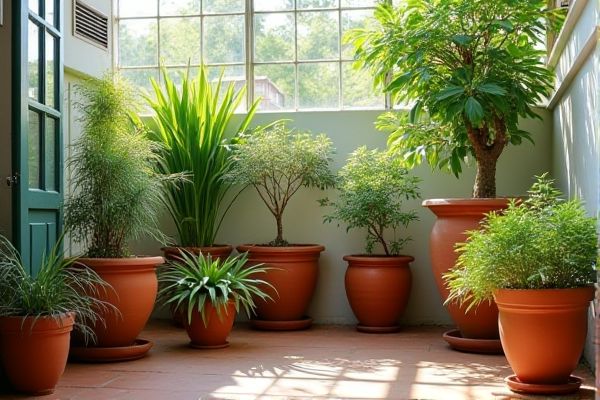
Clay pots offer superior breathability and natural insulation for terrace plants, promoting healthier root systems by allowing excess moisture to evaporate more efficiently than plastic pots. Explore the rest of the article to discover which pot type suits your terrace garden needs best and enhances your plant's growth.
Table of Comparison
| Feature | Clay Pots | Plastic Pots |
|---|---|---|
| Material | Natural, porous clay | Lightweight, synthetic plastic |
| Breathability | High air circulation, prevents root rot | Limited air flow, can retain excess moisture |
| Weight | Heavy, stable in wind | Light, easy to move |
| Durability | Fragile, can crack in cold | Resistant to impact and weather |
| Water Retention | Dries out quickly | Retains moisture longer |
| Cost | Moderate to high | Low to moderate |
| Aesthetic | Natural, rustic appeal | Varied colors and shapes |
| Eco-friendliness | Biodegradable, natural material | Non-biodegradable, plastic waste |
Introduction: Choosing the Right Pots for Terrace Plants
Clay pots offer excellent breathability and natural insulation for terrace plants, promoting healthier root systems by preventing waterlogging and temperature fluctuations. Plastic pots provide lightweight, durable, and cost-effective options resistant to cracking and ideal for mobility on terraces. Selecting between clay and plastic pots depends on factors like plant species, climate, maintenance preferences, and aesthetic goals for terrace gardening.
Clay Pots vs Plastic Pots: An Overview
Clay pots offer superior breathability and natural insulation, promoting healthier root systems for terrace plants by preventing waterlogging and temperature fluctuations. Plastic pots are lightweight, cost-effective, and retain moisture longer, making them suitable for environments requiring less frequent watering. Choosing between clay and plastic pots depends on the specific needs of the plants, including water retention, root aeration, and durability.
Aesthetic Appeal and Design Considerations
Clay pots offer a natural, rustic aesthetic that enhances the visual appeal of terrace plants with their earthy tones and textured surfaces. Plastic pots provide versatile design options with a variety of colors, shapes, and lightweight construction suitable for modern and minimalistic terrace gardens. Both materials influence plant health and overall decor, but clay pots often create a more organic ambiance, while plastic pots prioritize durability and ease of movement.
Durability and Longevity of Clay and Plastic Pots
Clay pots offer natural breathability that prevents root rot, but they are more susceptible to cracking and chipping in extreme weather, reducing their lifespan. Plastic pots provide superior durability with resistance to breakage and weather conditions, often lasting several years without significant degradation. For terrace plants, plastic pots are typically preferred for long-term use due to their lightweight and sturdy nature, while clay pots are favored for their aesthetic and natural moisture regulation despite lower longevity.
Water Retention and Drainage Performance
Clay pots provide superior water retention and natural drainage due to their porous structure, allowing excess moisture to evaporate and preventing root rot in terrace plants. Plastic pots retain water longer, which can be beneficial in hot climates but may lead to overwatering issues without proper drainage holes. Choosing clay pots enhances aeration and moisture control, helping your terrace plants thrive with balanced hydration.
Plant Health: Air Circulation and Root Growth
Clay pots enhance plant health on terraces by providing superior air circulation through their porous walls, which prevents soil compaction and root rot. This natural breathability promotes vigorous root growth and efficient moisture regulation, creating an optimal environment for terrace plants. Plastic pots, being non-porous, often trap moisture and limit oxygen availability to roots, potentially leading to weaker root systems and increased risk of disease.
Weight, Stability, and Space Utilization
Clay pots are heavier than plastic pots, providing greater stability for terrace plants, especially in windy conditions. Their weight reduces the risk of tipping over but may be less practical for rearranging frequently. Plastic pots are lightweight and space-efficient, making them easier to move and better suited for maximizing limited terrace space, though they may need additional support to prevent instability.
Environmental Impact: Sustainability and Recyclability
Clay pots offer superior sustainability due to their natural, biodegradable material that decomposes without releasing toxic substances, promoting a lower environmental footprint. Plastic pots contribute significantly to pollution as they are derived from non-renewable petroleum resources and often end up in landfills, exacerbating waste management issues. Recycling options for plastic pots exist but remain limited by contamination and degradation, whereas clay pots, though less recyclable, present a more eco-friendly lifecycle through natural breakdown.
Cost Comparison: Initial and Long-Term Investment
Clay pots typically have a higher initial cost compared to plastic pots due to their material and manufacturing process. Over time, clay pots offer better durability and breathability, reducing plant diseases and root rot, which can lower long-term maintenance costs. Plastic pots are cheaper upfront but may degrade or crack under sunlight, potentially requiring more frequent replacement and increasing overall expenditure.
Conclusion: Which Pot is Best for Terrace Gardening?
Clay pots offer superior breathability and natural insulation, promoting healthier root systems and better moisture regulation for terrace plants. Plastic pots are lightweight, affordable, and retain moisture longer but may cause root overheating and poor aeration. For optimal terrace gardening, clay pots provide better plant growth and durability, making them the best choice for your garden.
 homyna.com
homyna.com